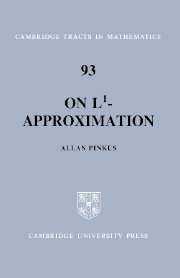Book contents
- Frontmatter
- Contents
- Preface
- 1 Preliminaries
- 2 Approximation from Finite-Dimensional Subspaces of L1
- 3 Approximation from Finite-Dimensional Subspaces in C1(K, μ)
- 4 Unicity Subspaces and Property A
- 5 One-Sided L1-Approximation
- 6 Discrete l1m-Approximation
- 7 Algorithms
- Appendix A T- and WT-Systems
- Appendix B Convexity Cones and L1-Approximation
- References
- Author Index
- Subject Index
4 - Unicity Subspaces and Property A
Published online by Cambridge University Press: 06 January 2010
- Frontmatter
- Contents
- Preface
- 1 Preliminaries
- 2 Approximation from Finite-Dimensional Subspaces of L1
- 3 Approximation from Finite-Dimensional Subspaces in C1(K, μ)
- 4 Unicity Subspaces and Property A
- 5 One-Sided L1-Approximation
- 6 Discrete l1m-Approximation
- 7 Algorithms
- Appendix A T- and WT-Systems
- Appendix B Convexity Cones and L1-Approximation
- References
- Author Index
- Subject Index
Summary
Introduction
Both Theorems 3.1 and 3.3 (see also Corollary 3.4) provide us with criteria for exactly determining when a given finite-dimensional subspace U of C(K) is a unicity space for C1(K, μ). Nevertheless there are at least two drawbacks to these criteria. In the first place the criteria are generally very difficult, if not impossible, to verify. Except for certain specific subspaces it is almost always impossible to check whether there exist h and u* satisfying the conditions of Theorem 3.1, or whether the inequalities of Corollary 3.4 are always valid. Secondly, the above-mentioned criteria are measure dependent. That is, a specific subspace U may be a unicity subspace for C1(K, μ1), but not for C1(K, μ2), where μ1 and μ2 are both ‘admissible’ measures on K. See Examples 3.1 and 3.3, and Exercise 8 of Chapter 3 where this phenomenon occurs.
It is therefore natural to ask for a characterization of finite-dimensional subspaces U of C(K) with the property that U is a unicity subspace for C1(K, μ) for all ‘nice’ measures μ. Perhaps such a characterization, while it would be interesting in and of itself, might also be easier to verify. Perhaps such a characterization will be an intrinsic property of the subspace U. Perhaps it might be possible to list all such subspaces. This is the problem which we investigate in this chapter.
In Section 2 we delineate a condition called Property A.
- Type
- Chapter
- Information
- On L1-Approximation , pp. 57 - 100Publisher: Cambridge University PressPrint publication year: 1989



